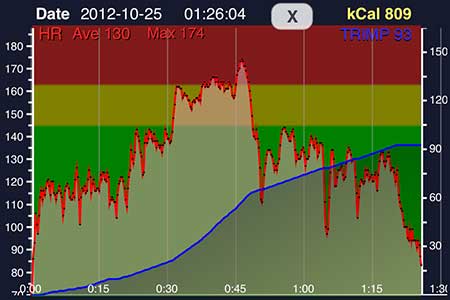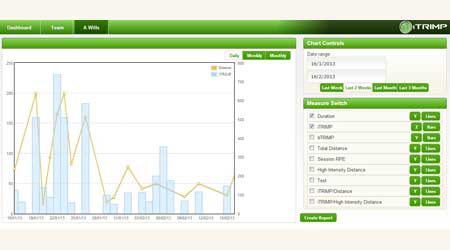
By Carl Valle
For years coaches have used heart rate to guide them in training, and as technology moves closer to the bionic age, we are not much better than our ancient hunters from years ago. Even with the Paleo movement and barefoot fans trying to imitate our ancestral cousins, some coaches are still stuck with the fact we cannot do a better job training, even if we can see random data plots on an iPhone. I have been enamored with heart rate training since my first time picking up Swimming Faster years ago, but lately it seems everyone is suggesting what to do with no examples of the results of such training. As Heart Rate moves to Heart Rate Variability (HRV) and now slicing to components of HRV, it is a good time to ensure we have a firm grasp of the basics before we get to some higher level aspects. The heart is a vital organ, but we need a balanced understanding that while it is informative, it does require some interpretation and common sense.
The heart is one of the most studied organs of the body for good reason; it drives life through the cardiovascular system and never stops working. While the brain arguably is the most marvelous, without the heart working, life stops when the heart stops. The heart does more than just pump blood; it is also an excellent diagnostic tool to understand what his happening during training. Several measurements like resting heart rate, maximum heart rate, and now heart rate variability are all metrics coaches are using to assess and monitor athletes. While it is great that we are doing this, we need to know what are the realistic expectations and benefits of monitoring the heart besides health and wellness. Athletes are often screened with treadmill tests that use EKG to ensure their heart is working normally. Teams and endurance coaches have used heart rate monitors for years to manage workload. This article shows the best ways to train athletes and what heart data we can actually use. I use the words training athletes as too many coaches are talking training “energy systems” or doing “cardiac output” training and nothing impressive has come from any of those thought processes. The simple use of a heart rate monitor, be it a chest strap, smart fabric shirt, or now near bionic device, can help reduce unnecessary overreaching and help maximize the results of conditioning programs.
Measuring the Heart — Anatomical and Physiological Methods
The heart at first glance looks like a large fist and has ventricles that help move blood by continually pumping about every second. While it acts like a muscle and adapts to stress by getting larger or pumping faster, it is far more complicated biological plumbing. The heart can also be seen as a neurological circuit. We will get into what that means in greater detail later, but for now realize that while some think it is a dumb muscle, it is smarter than we think. What we need to know are two simple questions.
- How do we use the physical heart measurements to know that training adaptations and the effects of the workouts are helping performance?
- How do we measure the beats or contractions of the heart to see how conditioning and recovery is working with training?
So in a simple summary, how can we make the heart better, and can we monitor the heart to make our training programs better. While the details need expertise, the direction is simple enough to help most coaches and athletes. Make the heart better and use the heart data to get better.
Measuring the Heart Size and Strength

Figure 1: The heart will actually enlarge the volume of the left ventricle over time, one of main adaptations from conditioning.
The heart does change in both wall thickness and chamber size from heavy training, but a little too much excitement comes from online articles on how much aerobic training can do for athletes, especially team sports and speed or power events. The body will adapt to the needs of the stresses, and not all adaptations are possible or necessary. Some adaptations frankly will not mean much in terms of performance or recovery abilities, and if one mentions any adaptation or benefit, I always ask what the value is before investing time or money into it. For example, with limited training times of team sports, are we looking to make changes to all areas of performance, and must address many needs in a short period of time. Studying endurance athletes who do a few triathlons or marathons a few times a year with a body type and skill need that is not aligned to soccer or basketball is frankly not very useful for the most part. When looking at improving the heart, we are really trying to improve the endurance abilities of athletes. Aerobic endurance, including but not limited to changes to the heart, helps athletes with the capacity to do more, or do the same more efficiently or easier.
Challenging the body to make a morphological change (structural change to the body) isn’t easy and doesn’t come from putting in an honest effort. Change comes from pushing the body so hard, it sends a strong and clear signal to become better, usually larger, faster, more efficient, and or more plentiful. The signal not only has to be loud and clear, it also has to be chronic and consistent; otherwise the body wants to stay at homeostasis. The issue is that unless you are a pure endurance athlete, the unrealistic expectations of making the left ventricle larger need to be lowered because normal changes from practicing and games are not going to get much better if one decides to focus for four weeks on endurance. Several recent presentations on adaptations to aerobic stimuli are gravely misrepresenting human biology. With the advent of foolish attempts in “oxidative strength training” and “cardiac output” workouts, just a few months are not going to change an athlete unless they have not been training in the past or usually just sit on the coach during the training period. Even if the deep block of training was successful, the extreme focus of efforts to tax the aerobic work usually failed to address the big picture with all of the other responsibilities. Concurrent work of speed, agility, mobility, and still training is more important because conditioning is usually overdosed to athletes by overzealous coaches, meaning we are usually doing too much or not having enough energy or resources to develop what we need. Either way the constraints of modern sport leave no room for the real change we need, unless schedules are radically changed to improve performance rather than entertainment. So if you see considerable discussion about making the heart bigger or stronger, remember that most athletes are not going to be able to make those changes from specific conditioning programs unless they are professional endurance athletes or at least training like them.
Measuring the Efficiency and Effectiveness of the Aerobic System
For decades coaches have used Heart Rate Monitors to observe the rise and fall of the heart rate for estimating effort and estimating conditioning. It is not rocket science that the heart rate increases as we put more effort out and chronic adaptations will usually lower resting heart rate and other measurements of fitness. Coaches have used morning pulse rate to estimate how efficient the heart is in pumping, since a stronger contraction means the body at rest will need less frequent contractions to move blood through the body. Athletes who challenge their hearts by elevating it aggressively usually see a decrease in resting heart rate. Elite cyclists are documented to be in the low 30s. A more mixed athlete (speed and conditioning) for team sports are in the 40s and 50s, and a fitness enthusiast is usually under 60 beats per minute. All of this is at rest, and specially laying down supine. When the resting heart rate is elevated, we can interpret the score as the athlete losing general fitness, losing health, or sometimes temporarily overtraining. Monitoring the resting heart rate means we need to know how it is done (standing or lying and or with a specific device) and what contextual details are present such as training loads and health status. The heart is conveniently summarized with the beats per minute but as an indicator of performance one can’t speculate it will be the deciding factor for success. Other adaptations of the aerobic system such as capillary growth, enzymes, endocrine system adaptations, and pulmonary changes are theoretically helping oxygen and substrate utilization during aerobic exercise. The heart rate is easy to measure, so it tends favor its use with coaches.
Like resting heart rate, the rapid lowering of the heart rate after a bout of effort or entire workout is an important sign of fitness and an indicator of what the Autonomic Nervous System may be experienced. When stress is chronically affecting the body, recovery is incomplete and performance is impaired. Signs of being overly taxed can be seen not only during the session if compared to similar and past sessions, but this may carryover later to the next day or longer.
If one is trying to use a continuous monitoring approach, meaning looking at activity during training or competition, interpretation is obviously needed to see if the athlete is performing well. Having a high or low heart rate is not a sign of success, as even the best endurance athletes may not have the lowest heart rates during the most prestigious events in endurance sport. So the question is how do we use heart rate monitoring with individuals and groups to make better choices in training?
Effective Heart Rate Monitoring Strategies
My experience with heart rate monitoring started in high school, with curiosity and love for technology making me invest into getting an old Polar watch and strap. Not much insight beyond working harder increases the number and I have gone into the 200s just a few times. I have used it to see how low I could get my resting heart rate by relaxing, a primitive form of biofeedback. Unfortunately, most casual users end up tossing their equipment into a storage bin next to the other gadgets because they don’t know how to use the device properly.
What makes heart rate data useful, is when we can reveal trends training and competition and have better results more consistently compared to not using it. While some programs don’t use heart rate data at all, no program is perfect, so the use merits some consideration when athletes are not responding well.
When coaches are working with elite athletes, most assume that complicated formulas and exotic lab experiments are needed to get value of using a heart rate monitor. Coaches have many questions about target heart rate and finding the optimal heart rate zones, and while that is all nice to know with some endurance athletes, the real need is to individualize heart rate monitoring with training. Coaches need to appreciate what they are doing with training, and let sport science support what is working, not try to force feed heart rate monitoring into the process. When great workouts become bland lab experiments, the information collected usually isn’t shocking but the training is compromised. It is better to use heart rate monitoring to get a sharper indication of training, rather than change training to accommodate data collection. Coaches should consider three primary strategies and measurements. They are the following:
- Morning Heart Rate and Morning Heart Rate Variability
- Recovery from Bouts and Workouts
- Estimated Load with TRIMP and other similar measures
Anything additional to those three above metrics is very questionable. Most athletes need to see daily strain on their bodies, gage fitness changes, and estimate training load physiologically. Many other sensitive measures exist but it is about what likely decisions are made and most coaches have 3-5 levels of effort in training. A day off, an easy recovery day, a maintenance day, hard day, and maximal or near maximal effort day — all common in most coaching circles.
Over a year, not much more fine-tuning is going to show up given that training is about seasons and not one magic session. My belief is that sustainable a practice done longitudinally is the path to improvement over time, and this includes monitoring approaches with heart rate. Don’t get too excited when someone shows a week of training with amazing insight, because that usually requires training over multiple years. Coaches need just enough information to have a firm judgment of what is working but not so much information it is overkill.
Resting Heart Rate and Heart Rate Variability

Figure 2: Above is daily HRV readings for two years and the band lines suggested by Stephen Few are easy ways to interpret fatigue and capacity of athletes.
Every day the athlete should wake up and get a morning pulse rate either lying supine or standing. Some research will suggest one or the other or both, but the main goal here is to look for change. Some of the changes will slow and require interpretation, but we are looking for a fit heart for athletes in team and power sports and with endurance, a high performance heart. The difference with endurance athletes is they are highly extreme and need very efficient hearts to be competitive, while team sports need an array of qualities such as power and athletic skills, and power athletes need health and wellness for recovery needs. Standing heart rate scores will create a small amount of sympathetic stress and have higher beats per minute, and lying down will decrease the beats per minute. While a perfect or normal heart rate is nearly impossible to give out, athletes should be consistently in their 50s for team and power athletes, and 30s and 40s for more endurance athletes is normal in the supine position. Obviously when fatigue begins athletes will have their BPM (beats per minute) higher and that will throw off the daily average, but resting heart rate is not just about first morning rest. Rest after a few days going easy and the body is recovered. After weeks of smart training, adaptations to the heart will begin and over seasons we should see a significant change. Those morphological improvements should manifest with a lower resting heart rate. While not a cardinal sign of improvement or other biological changes, it is a good bet that other favorable changes such as capillary density and enzymatic improvements have occurred.
Heart Rate Variability or HRV, is a measurement of time between hearts instead of the rate of beats per minute. The subtle differences in fractions of a second between contractions is actually very meaningful, meaning the steady beat paradoxically is sign of strain and higher variability is a better status to the Autonomic Nervous System. New technologies that are smartphone friendly are making what only elite athletes had access to available to the consumer level athlete, and HRV adds more precision to morning heart rate. HRV is not a replacement to resting heart rate, but it is a great complement that can help monitor the physiological load from the previous training day. Watching HRV over days and weeks is very useful, but treat it as an early warning system rather than a diagnosis of what is going on. Morning HRV and weekly trends ask better questions, but can’t answer more than just fatigue. Different companies are providing HRV scores with internal proprietary scores and the main players here are iThlete, Omegawave, and Firstbeat. I predicted the smartphone would provide a disruption to the old laptop PC and lab like approach that was not scalable six years ago, and now we have easier and simpler ways of collecting that information. When data collection is faster and more compliant, interventions are more applied and more likely to be delivered.
Heart Rate Recovery Analysis

Figure 3: Coaches want to know if athletes can do the same work with less effort and recuperate just as fast or faster when monitoring a recovery workout. Featured is the Precision Pulse from the maker of iThlete.
The next step to monitoring heart rate is to evaluate the ability to recover from standard bouts of work, ranging from repeated intervals to entire workouts. The execution and interpretation of this process are far more complicated than one may think, so I prefer very clear workouts to be assisted by heart rate monitoring. In fact, most workouts are not appropriate to guide coaches in fitness unless they are consistently the same in all variables in order to rule out variables. When I use recovery rate, or how fast one recovers from repetitions, sets, and sessions with conditioning bouts, I look for clear and simple revelation. While it is great to be so precise one can predict the future like a medium, I never like predicting anything positive since being at one’s best is a small window of opportunity. Still, we are trying to move the needle and make progress, so these statements/questions are good enough in my book.
- Is the athlete getting in better condition?
- Is the athlete getting out of condition?
- Is the athlete staying in condition?
- Is the athlete overreaching and needs prescribed rest?
A good time to test the athlete is during a consistent workout done for recovery or warm-up. Remember, don’t change the training to get testing; find a way to create testing from the options one normally uses.
As previously mentioned, the warm-up or recovery session needs to be effective in creating a similar load throughout the season in order to make a correct comparison. I like using the tempo running since it’s popular and the speeds are usually precise enough to keep the load standardized. Provided the volume and rest intervals are the same, one can see how each repetition, each set, and the entire session itself is responding. Remember a high heart rate doesn’t always mean someone is trying, it could mean they are out of shape, but it is a good idea to see if they came more tired than usual and see how bad they respond. If an athlete can’t run, intervals on the bike and in the pool follow the same structure, and you are looking for the slope, or rate of recovery from the end of the effort to the start of the next one.
A professional football team can do 3 x 6 x 110 yards if coaches want to see if athletes are deconditioned slightly from injuries and missing practices. While attendance, a crude metric by most standards, is vague, it is a good indication why athletes are in shape or out of shape. I like 3 x 5 x 200 @ 60-65% velocity once a week for many sprinters who are doing a heavy GPP or SPP phase, and use morning HRV and HR as monitoring during the competitive season as it is passive and most athletes are so sore warming up is sometimes all they can do.
TRIMP and Training Load for Team Sports

Figure 4: Training Loads are now using SaaS or Software as a Service model to estimate work in practices. While GPS and other techniques are excellent, the price value of Heart Rate is an excellent investment. The system above is from iTrimp, a cloud software option for teams of all levels.
Linear running is a safe and great way to control conditioning but that is usually once a week or part of a singular training session. Most practices simulate games, so the chaotic efforts make it far more difficult to estimate true effort. GPS and Prozone show the displacement and distribution of the work with athletes, but physiological strain is more internal, and the combined approach helps see how specific output is affecting the athlete internally.
Decades ago, TRIMP was invested by Dr. Bannister by multiplying out minutes of activity by the average heart rate. TRIMP scores are one option that many coaches are using to estimate effort during a training session, be it a heavy scrimmage or an easy small-sided game midweek. The attempt to calculate the total work and slice up the efforts based on zone like distributions was further evolved over the years and now neural networks and other high-end calculations are integrating TRIMP scores. TRIMP scores are not real physiological metrics, and use Arbitrary Units (AU) because time and heart rate outputs are multiplied out. Several options besides TRIMP scores exist, but the value beyond simple summaries isn’t going to help much when other stress metrics are included in the mix, such as weight training, morning HRV and HR, and other testing such as counter movement jumps and athlete feedback.
Simple evaluation and raw data are part of looking at the big picture. Raw data is part of best practices since any filtering and cleaning of data sometimes will remove the value. Raw heart rate data should be saved in isolation and the time stamps with some contextual factors be listed with the heart rate file so the data can be weighted. For example weather is highly variable and athletes running in the hot and humid conditions may have enough differences to see on heart rate data. Just having tags of dates and player names is not enough anymore, and environmental data is extremely important for context.
Other factors must be considered as well, such as use the of stimulants (caffeine and illegal drugs) and player psychology. Athletes are emotional creatures and while subjective monitoring isn’t perfect, when combined with physiological monitoring it is highly effective for improving the accuracy of player surveillance.
Making Heart Rate Monitoring Fit for You
Heart Rate monitoring is just a small component of training athletes. No perfect and complete solution exists today. The best way to start out with an approach is to do a better job with small and humble approaches and build each year. With enough resources anything is possible, but it is amazing how many barriers exist with something as small as morning pulse rate. Each year it is important to add more without forgetting about the data one got earlier, and it is hard to add without subtracting so do as much as necessary, not as much as possible as Henk Kraaijenof has suggested. Covering the bases with monitoring is more realistic than Utopian. Down the road each coach and athlete will find what adjustments work for them, and the goal is to see better results not be perfect. Fatigue is normal and necessary, but it needs to show effective adaptations with higher levels of training and performance later.
Please share this article so others may benefit.
[mashshare]


Thanks for taking the time to write this up. I have been reading a lot about using heart rate monitors in athletics and your write up is well written.
I was looking at the SaS iTrimp and it looks great and is reasonably priced but i cant find what hardware it works with?
Do i have to enter the HR data in by hand?
Thank you
Great post. Well done. Just to add on the applications for HRV, at iTHRVE we’ve developed an app that measures HRV and offers breathing cues to optimise sports performance. It works on iPhone and iPad and uses finger sensors or chest sensors where you can record your HRV over time. A great new feature (apart of HRV) in iTHRVE is to measures craniosacral rhythm which is critical for recovered time in sport. This is the only HRV app that also has craniosacral rhythm function. Usually, to evaluate your craniosacral rhythm one would have to go to a craniosacral osteopath or therapist. Now you can see and monitor your own craniosacral rhythm from your smart phone.